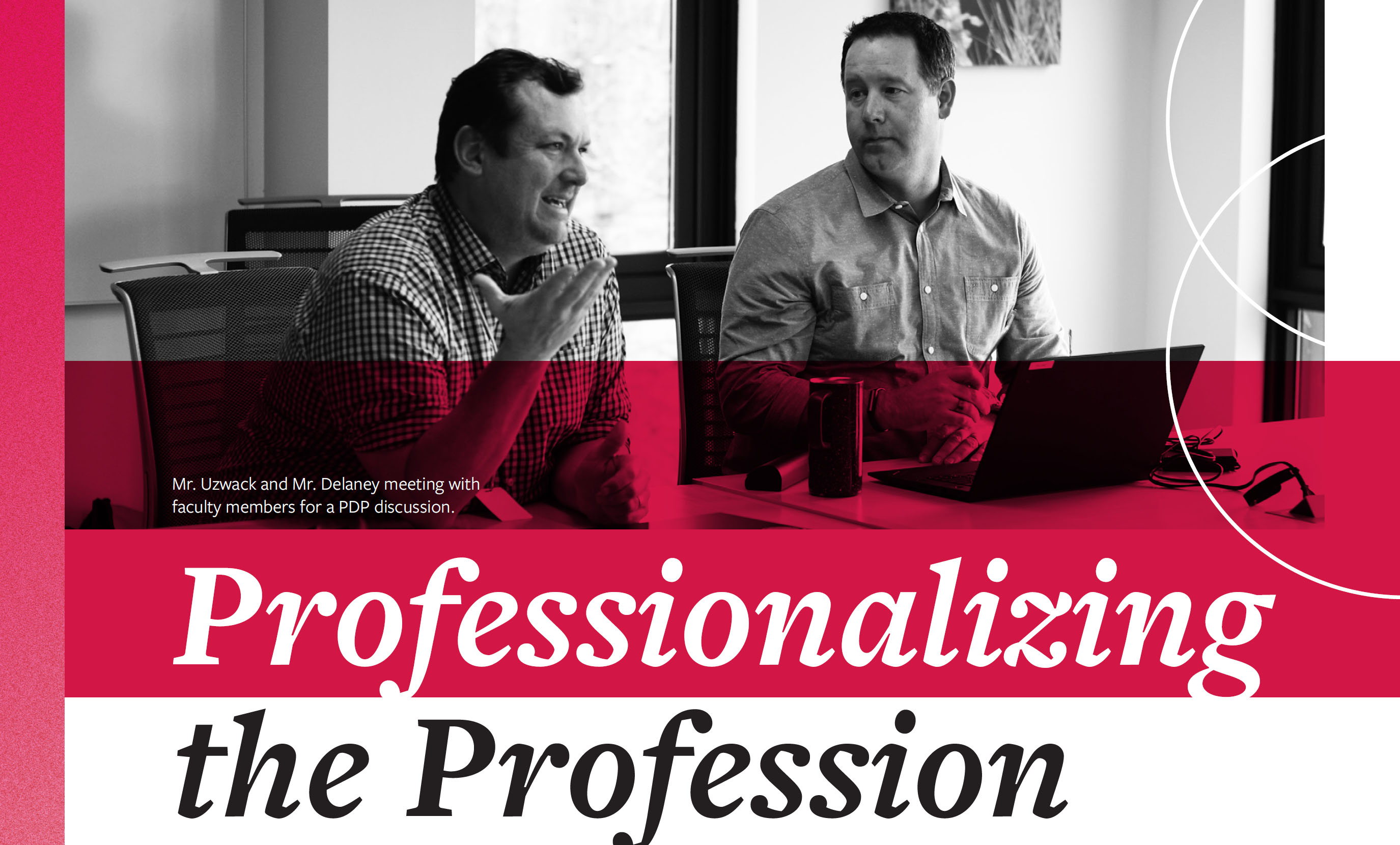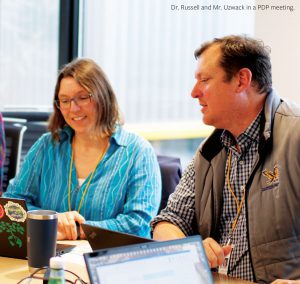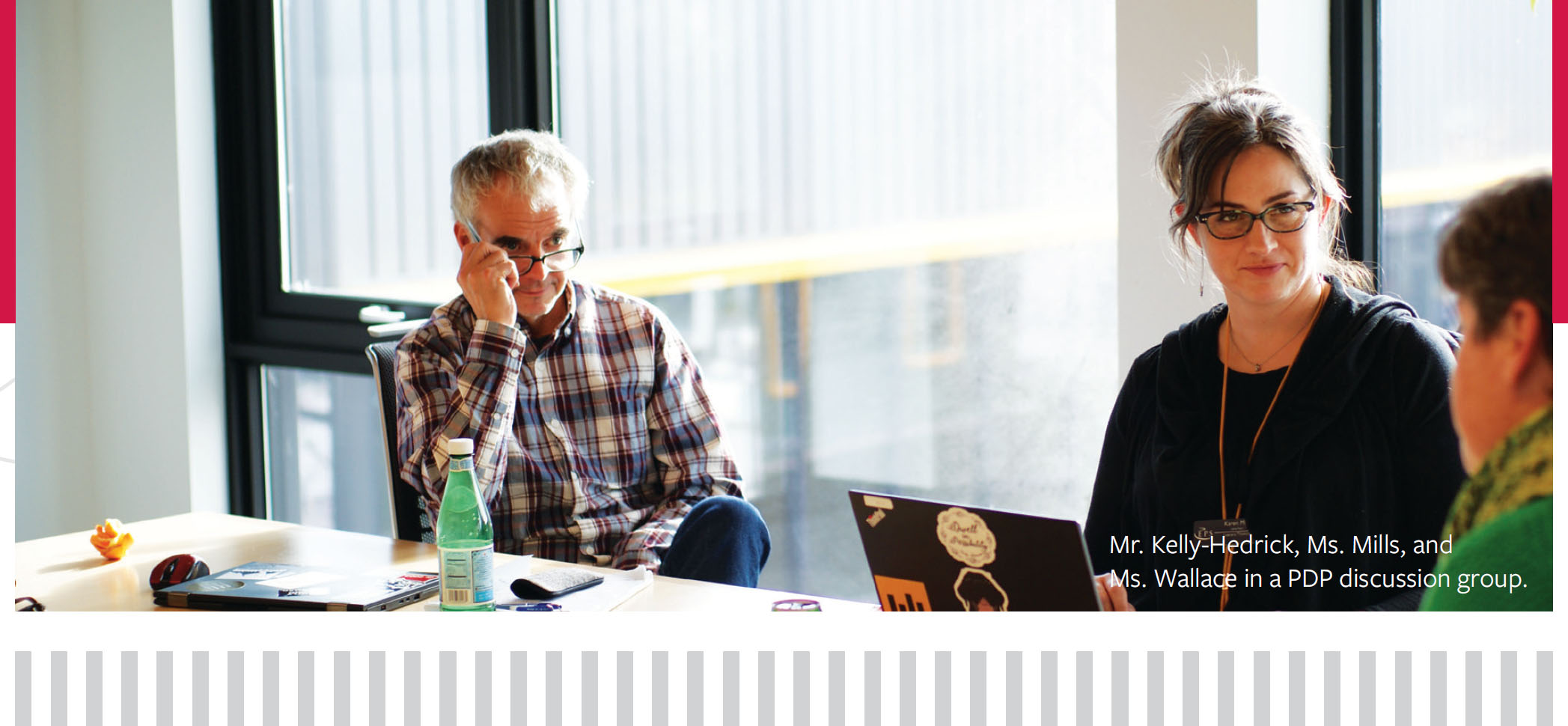
THE EPS PROFESSIONAL DEVELOPMENT PROJECT
By Sam Uzwack, Head of Middle School and Student Support Services
ABOUT TWENTY YEARS AGO, I graduated from the University of Washington Master in Teaching program. A few months later, I found myself in an Arctic village, teaching middle school reading, science, and language arts. My career was launched.
As an Eagle Scout, I had learned about ranks, requirements, and merit badges. There was always a “next step.” During the course of my first year of teaching, I had a stunning and troubling realization: I am a teacher. And from now until I retire, I will always be a…teacher.
Where was the next step? How did I earn the next rank? Where was the ladder?
Truth is, there really isn’t one in K-12 education. Sure, some people, myself included, are interested in being a principal or division head, but to do so is not exactly a “next step” in teaching. It is about teaching, for sure, but it is also about budgets, schedules, employee reviews, managing people, partnering with parents, student discipline, and so forth.
So, what about teachers who want to grow, advance, and develop within the classroom? Where is their path?
That is precisely the question our Head of School, Dr. Terry Macaluso, has been asking herself for years. Whether it was at Colorado Academy, St. Mary’s, or Lakeside School, the issue remained the same. Where was the program, structure, and culture to professionalize teaching so that people are rewarded and honored for developing within the classroom?
Then she started a new school named Eastside Prep—a school that is laser-focused on teaching pedagogy (jargon alert), enhancing student experience, and treating its faculty and staff like the professionals they are. After years of drafts, conversations, and pilot programs, we finally launched the Professional Development Project (PDP) last June.
 THE EPS PROFESSIONAL DEVELOPMENT PROJECT
THE EPS PROFESSIONAL DEVELOPMENT PROJECT
So what is this project? Put simply, it is an expression of the expectations for teaching at EPS. It is the manifestation of what it means to be a member of the community. And it provides a framework for development over the long term.
The PDP is organized by four domains and nine categories:
RELATIONAL CULTIVATION
(PLAYING NICE WITH OTHERS OUTSIDE THE CLASSROOM)
- Collegial Dynamics
- Community Membership and Support
CURRICULAR DESIGN AND COLLABORATION
(WRITING WHAT WE TEACH AND IMPROVING WHAT WE DO)
- Curriculum and Discipline Design
- Program and Professional Development
PEDAGOGICAL PRACTICE
(FANCY WORDS FOR TEACHING IN THE CLASSROOM)
- Classroom Culture
- Pedagogical Effectiveness
- Differentiated Instruction and Assessment
PROFESSIONAL PRACTICE
(DOING THE JOB)
- Professionalism and Executive Functioning
- Assessment Practice
These categories provide a broad framework for what it means to teach at EPS. Under each category are three to five specific indicators including:
- Develops mutually respectful and productive relationships with colleagues
- Recognizes and supports diversity in all its forms
- Designs and implements courses that reflect knowledge of both academic discipline and school-wide curricula
- Varies activities in each class period
- Approaches recommendations for improvement receptively and responsively
- Designs assignments to be graded and returned in a feedback cycle of seven days
Now that there is a shared language to talk about what we do at EPS, how does this become real? How is it used?

PROFESSIONAL LEVELS
When teachers arrive at EPS, they are placed in one of five professional levels:
Instructor
Teacher
Senior Teacher
Master Teacher
Mentor Teacher
It is important to note that these are EPS-specific designations. While all of our faculty are high-quality instructors, we wanted to create a progression that ultimately leads to increasingly complex professional development opportunities. The first three levels are about focusing on one’s own practice and place in the community. In fact, each faculty member needs to achieve Senior Teacher by the end of their twelfth year at the school. The final two levels, Master and Mentor Teacher, are all about putting energy back into the school ecosystem.
It is becoming increasingly difficult to recruit high-quality independent school teachers, particularly to the Seattle metropolitan area. Housing prices make the area a very difficult place to move to as an early-career teacher, not to mention that the available pool of independent school teachers is already strained. To address this challenge, EPS is developing a Resident Teacher program aimed at people who have just earned their degree in an academic discipline area (i.e. math, literature) and are considering a career in teaching. We could, in a sense, “grow our own” teaching pool. Resident Teachers would be provided housing, a meal allowance, and a monthly living stipend. In exchange, they would work with our Master and Mentor Teachers to learn the art and science of teaching. This would not only benefit EPS directly, but the surrounding independent school community.
While Master Teachers have the opportunity to mentor Resident Teachers, Mentor Teachers can do that plus qualify for a mini-sabbatical. This break might be spent doing a deeper dive into their academic discipline at a college, industry leader, or another educational institution.
Equally important to a progression of responsibilities and status, each “leveling-up” brings with it an increase to base salary. In this way, the incentive to develop and grow within the context of the classroom is rewarded through increased professional opportunities within the school and the compensation one receives.
PROFESSIONALLY DEVELOPING
So you have a framework for teaching at EPS, and you have created a “ladder” of advancement within the institution. What are people actually doing?
This is the multiplying effect of the Professional Development Project—and it is one of the key features of this program. Each candidate for advancement to the next Professional Level has a Feedback Team of four or five fellow faculty members. While the candidates are selecting artifacts that speak to the category indicators and reflecting on their practice, Feedback Team members are observing classes and providing critique. This means that in addition to the five candidates engaged in the process this year, twenty more individuals are engaged in a deep dive about their own practice. Further, as we tune all of our school-wide processes to the PDP (such as Student Experience Surveys), the values of the school represented by the framework are pushed deeper into the school. The framework becomes a common reference point when we talk about any aspect of our work at EPS. It also helps create a healthy culture of feedback in which we all grow more adept at giving praise and providing critical feedback.
It’s big…it’s audacious…and it’s about time. Since its inception, EPS has worked tirelessly to become a place that carries the art of teaching to new heights. It is a place where one goes to “geek out” on teaching. Now, we are setting our sights even higher, in order to create a model that might impact the independent school landscape on a broad scale. As of this magazine going to press, EPS is applying for an Edward E. Ford Foundation grant to further fund this project. The Foundation grants awards to independent schools pursuing projects that not only impact their communities, but are also scalable and applicable to other schools nationwide. It is our hope that not only can we create a better world for our own teachers, but also for teachers far and wide.

